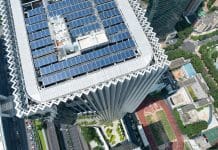Rob Smith, CTO at Creative ITC, explains the often-underestimated impact of enterprise technology on climate change and outlines how construction businesses can stay ahead of the ESG curve
Growing environmental awareness in the construction sector has prompted widespread adoption of more sustainable design and build practices.
The construction sector, responsible for a staggering 40% of global energy consumption and a third of greenhouse gas emissions, is under increasing pressure to demonstrate its commitment to making a net zero future a reality.
Rising concern about the significant impact of the built environment on climate change has triggered increasing emphasis on ESG requirements in tenders. Time is being called on organisations hiding behind carbon offsetting claims.
With a suggestion of stricter measures to come, there’s a growing possibility that firms could soon be excluded from bidding for projects unless they can substantiate their sustainability claims.
Construction firms also face changes in the regulatory landscape to drive more rigorous reporting and accountability.
ESG disclosure laws are mandatory in the UK, the EU Non-Financial Reporting Directive (NFRD) has been extended, and the US Securities and Exchange Commission has proposed new climate-risk disclosure requirements.
There’s also a renewed industry-wide focus on tackling these issues. Architects Declare and UKGBC are among the groups pushing to accelerate change, and The Royal Institute of British Architects (RIBA) has advocated better use of technology to meet sustainable development goals.
Its Smart Building Overlay guide calls for using smart building technology to implant environmental responsibility into new construction and retrofit projects.
While this is a significant step by RIBA, it’s crucial that the industry doesn’t ignore the importance of sustainable technology in overall operations.
Confronting the carbon challenge
For too long, IT systems within the construction sector have sat just under the radar, without revealing their true environmental cost. With enterprise technology accounting for around 1% of global emissions, it’s an area ripe for an ESG revolution.
Outdated IT systems are more than a bottleneck for efficiency. Their substantial carbon footprint is comparable to some of the world’s most intensive industrial activities – the equivalent of half of all emissions from global aviation and shipping.
Unfortunately, many construction companies aren’t practising what they preach. Working practices within many firms themselves lurk hidden behind the headlines celebrating their latest sustainable project win.
It’s commonplace for architects, designers and engineers to work on eco-friendly developments using power-hungry CAD workstations that don’t maximise the use of renewable energy. The alarming carbon output of these legacy IT systems is now under closer scrutiny.
The construction industry is at an important juncture, where the sustainability of our built environment and the digital infrastructure that supports it are inextricably linked. As the global community ramps up efforts to meet stringent ESG criteria, it’s clear that construction businesses must pivot towards smarter IT choices to stay ahead of the curve.
Practical steps to sustainable IT
Implementing sustainable IT is not about simply reviewing infrastructure to drive carbon reduction; it’s also about instigating new attitudes and behaviours to transform working practices and operational efficiency.
Adoption of Desktop-as-a-Service (DaaS) is one of the steps IT teams can take to boost workforce mobility and collaboration, while also contributing to their organisation’s environmental goals.
One more sustainable alternative to traditional CAD workstations is VDIPOD, a purpose-built DaaS solution hosted by data centres operating on 100% renewable energy. It reduces firms’ IT power consumption and carbon emissions and also provides organisations with metrics and an audit trail to simplify ESG reporting.
One international architecture studio reduced kilowatt hours per person by 90% and tripled its usage of renewable power by migrating 400 architects and designers to VDIPOD.
Another step to help lower an organisation’s environmental impact is to move to an Infrastructure-as-a-Service (IaaS) model. With fully managed IaaS, responsibility, power consumption, and carbon footprint transfer to the service provider. Without the need to maintain on-premise technology, IT teams can decrease energy usage, cooling costs, and equipment waste.
AtkinsRealis is working to reduce its 16 global data centres to three by migrating to Creative ITC’s private cloud. This cloud operates on 100% clean, renewable energy and delivers industry-leading power efficiency.
“One of the biggest benefits we’ve already seen in our carbon footprint is we’ve reduced storage by 69%, electricity by 53% and floorspace by 45%,” said Steve Capper, AtkinsRealis Group CIO.
Making wise environmental choices about where to host data and services can have a significant impact on ESG performance. As the cost of designing and implementing their own green data centre is unviable for most companies, many have explored public cloud options. Now, with hyper scalers increasingly castigated for poor environmental controls, smaller cloud providers may be a more environmentally friendly alternative for construction firms.
Using data centres powered by renewable energy enables firms to align their IT footprint with their ESG ambitions. It’s also important to scrutinise IT suppliers’ credentials to strengthen sustainability through smart supply chain partnerships.
Unlocking value
The benefits of ESG-focused IT choices extend well beyond environmental compliance. Investment in sustainable technology not only ticks the ESG scorecard – it’s also a step towards unlocking competitive advantage.
In addition to contributing to global goals, businesses adopting best practices enjoy operational and financial rewards. Companies taking positive ESG action avoid financial risks and open new funding opportunities – three-quarters (79%) of investors place importance on the way a company manages ESG.
Sustainable companies outperform peers on profitability and EBITDA and enjoy increased productivity, growth and lower costs. With rising ESG requirements, they’ll have more opportunities to bid for tenders and face fewer regulatory interventions.
Smarter working practices can unlock tangible business benefits as the ESG narrative shifts towards value creation. Firms that embrace sustainable IT are not just helping to mitigate climate risks but also positioning themselves as frontrunners in a future where ESG has already become a competitive differentiator.
Business and IT leaders should remember these benefits and take every opportunity to transform their operations for the better. Their firm’s and the planet’s future success depends on it.














